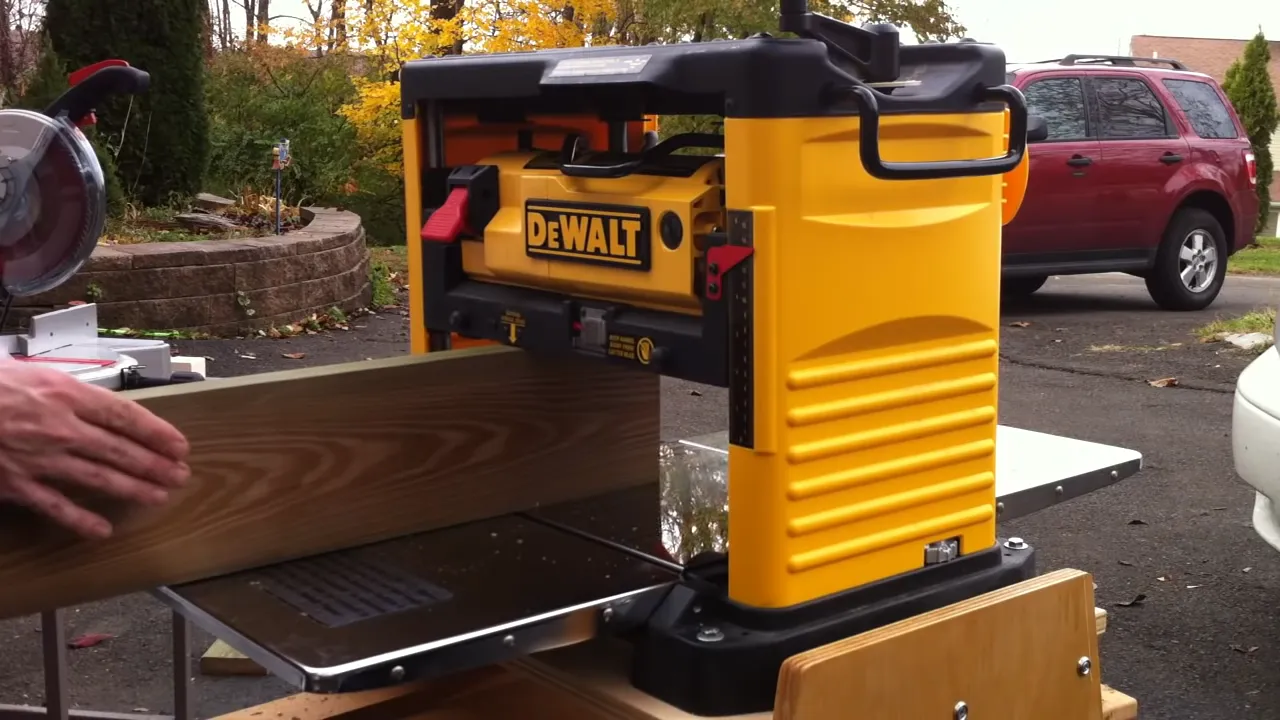11 Reasons Delta Planer Won’t Turn On [Fixed]
Are you eager to start your woodworking project, but your trusty Delta planer refuses to turn on? Don’t fret! We’ve got you covered with this comprehensive guide that delves into eleven common reasons why your Delta planer might not be powering up and offers detailed, step-by-step fixes for each issue. Before we dive in, always prioritize safety – make sure to unplug the planer before attempting any repairs. Now, let’s get to the bottom of this and get your planer up and running again!
1. Broken Contact Switch
The Issue: One of the primary reasons your Delta planer may not turn on is a malfunctioning contact switch. The contact switch serves as a crucial link in the electrical circuit, enabling power flow when the planer’s power button is pressed.
The Fix: To tackle this issue, start by unplugging the planer from the power source to ensure your safety. Next, access the front cover of the planer to locate the contact switch. With the help of a screwdriver, disconnect the wires connected to the old switch and carefully replace it with a new one. Once the new switch is in place, reattach the wires securely. Finally, plug the planer back in and test if it powers up. If all goes well, you’re ready to get back to your woodworking project!
2. Blown Fuse
The Issue: Another common cause of a non-responsive Delta planer is a blown fuse. The fuse acts as a safeguard against electrical overloads and short circuits.
The Fix: To tackle this problem, you’ll need to locate the fuse box in your planer. Before proceeding, make sure the planer is completely disconnected from the power source. Open the fuse box and inspect the fuse for any signs of damage, such as a broken filament or discoloration. If the fuse appears blown, replace it with a new fuse of the same rating. This simple fix should restore the planer’s power, and you’ll be ready to continue with your woodworking endeavors.
3. Tripped Circuit Breaker
The Issue: A tripped circuit breaker could be to blame if your Delta planer suddenly stops working. This happens when there is an excessive electrical load on the circuit.
The Fix: To remedy this situation, begin by locating your home’s circuit breaker panel. Look for any breakers that have flipped to the “off” position. If you find one, switch it all the way to the “off” position and then back to the “on” position. This action will reset the circuit breaker. Now, plug the planer back in and check if it powers up. If the circuit breaker trips again, you may have other electrical appliances drawing too much power on the same circuit. In such cases, redistribute the load or consider running the planer on a separate circuit to prevent future issues.
4. Defective On/Off Switch
The Issue: If your Delta planer’s on/off switch is defective, it can prevent the flow of electricity to the motor, causing the planer to remain unresponsive.
The Fix: To investigate this further, you’ll need a multimeter to test the continuity of the on/off switch. Begin by unplugging the planer and then carefully remove the switch cover to access the switch. Set your multimeter to the continuity test mode and touch the probes to the terminals of the switch. If the multimeter does not show continuity when the switch is on and does show continuity when the switch is off, it indicates a faulty switch. In such a case, it’s time to replace the defective on/off switch with a new one. Make sure to follow the manufacturer’s instructions to ensure a proper installation.
5. Damaged Power Cord
The Issue: A damaged power cord can interrupt the flow of electricity to your Delta planer, causing it to remain stubbornly inactive.
The Fix: To address this issue, unplug the planer from the power source and carefully inspect the power cord for any visible signs of damage. Look for cuts, fraying, or exposed wires. If you spot any issues, it’s crucial to replace the power cord with a new one that matches the planer’s specifications. Remember, working with damaged electrical cords is hazardous and should be avoided at all costs. By installing a new power cord, you can ensure a secure electrical connection and get your planer back in action.
6. Dust and Debris Accumulation
The Issue: Woodworking projects can be messy, and over time, dust and debris can accumulate inside your Delta planer, leading to electrical connection problems.
The Fix: It’s essential to clean your planer regularly to prevent dust and debris from causing issues. Start by unplugging the planer to ensure your safety. Next, use compressed air or a soft brush to clean the interior thoroughly. Pay special attention to the electrical components and wiring. Removing the accumulated dust and debris should help restore proper electrical connections and improve your planer’s performance.
7. Obstructed Parts
The Issue: Sometimes, your Delta planer’s smooth operation can be obstructed by foreign objects or debris lodged in critical parts.
The Fix: To address this problem, you’ll need to inspect the moving parts of your planer. These may include the elevating screws, blades, and other components responsible for raising or lowering the planer. Carefully examine these parts for any signs of blockage or obstruction. If you find any debris or foreign objects, remove them gently to allow the parts to move freely. Once you’ve cleared the obstructions, test your planer to see if it now turns on smoothly.
8. Worn-out Carbon Brushes
The Issue: Your Delta planer’s carbon brushes play a crucial role in supplying electricity to the motor’s armature. Over time, these brushes can wear out, leading to power issues.
The Fix: To inspect and replace the carbon brushes, begin by unplugging the planer to ensure safety. The location of the brushes may vary depending on your planer model, so consult your planer’s manual for guidance. Usually, you’ll need to remove the brush caps from the motor’s side to access the brushes. Check the length of the brushes – if they are less than 1/8 of an inch, they are worn out and need replacement. Install new carbon brushes, making sure they are properly aligned and making good contact with the armature. Once the new brushes are in place, reattach the brush caps securely. Now, your planer should have a fresh supply of electricity and turn on with ease.
9. Faulty Key or Switch
The Issue: Your Delta planer’s power activation might depend on a key or switch that could be faulty, preventing the planer from turning on.
The Fix: To investigate this, unplug the planer and inspect the key or switch. Depending on your planer model, the location of the key or
switch may vary. Use a multimeter to test their functionality. Set the multimeter to the continuity test mode and touch the probes to the terminals of the key or switch. When activated, the multimeter should show continuity, indicating the key or switch is functioning correctly. If there is no continuity, it means the key or switch is faulty and needs replacement. Consult your planer’s manual or reach out to the manufacturer for the appropriate replacement part. Once the new key or switch is installed, you should be back in business with a fully operational planer.
10. Problems with Adjustability or Binding
The Issue: Sometimes, issues with your Delta planer’s adjustability or binding can affect its power-up functionality.
The Fix: Begin by unplugging the planer to ensure safety. Next, inspect the handle, gear, sprocket, knob, and chains for any signs of damage or binding. Lubricate the moving parts if needed to ensure smooth operation. If any components are worn-out or damaged, replace them with new parts to restore the planer’s adjustability. Properly functioning adjustability mechanisms will enhance your planer’s overall performance and make it easier to use for your woodworking projects.
11. Electrical Issues
The Issue: In rare cases, your Delta planer’s electrical problems might be more complex, involving the motor or wiring.
The Fix: If you’ve tried all the above fixes and your planer still refuses to turn on, it’s possible that there are underlying electrical issues that require professional expertise. In such cases, seek assistance from a qualified technician or contact the manufacturer’s customer support for guidance. Attempting complex electrical repairs without the necessary knowledge and experience can be dangerous and may even void your warranty. Professionals have the expertise and tools needed to diagnose and fix intricate electrical problems effectively.
By now, you should have a good understanding of the potential reasons why your Delta planer won’t turn on and how to fix each issue. Remember to follow the safety precautions, consult your planer’s manual, and don’t hesitate to seek professional help when needed. With a well-maintained and fully operational planer, you’ll be all set to embark on your woodworking journey with ease and precision! Happy woodworking!



